In the past two posts, I explained why a carbon steel pan is a great idea for making stir fries, and how to season your new carbon steel pan. In this post, I will teach you all the tips and tricks on carbon steel pan care, so your pan will last a lifetime and perform well for you. The post includes advice on how to properly clean the pan, how to cook with it, and what to avoid. Follow these guidelines so your pan will stay nonstick and create great tasting food!
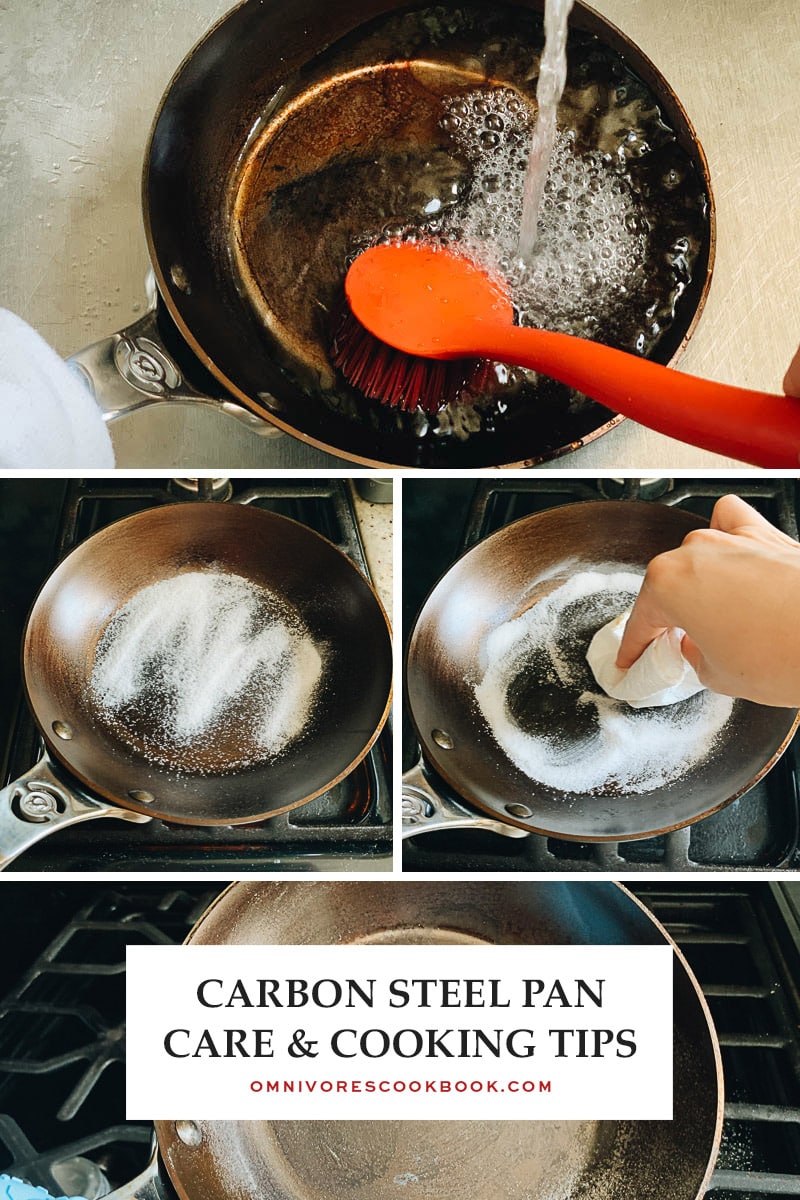
How to clean a carbon steel pan
Cleaning a carbon steel pan might look complicated. But once you try it a few times, it will become your ritual and take very little extra time.
It’s easiest to clean a carbon steel pan when it’s still hot. To clean the pan:
- Run hot tap water over the pan and use a wok brush to scrub the food residue. DO NOT use dish soap.
- If there’s any very tough residue that’s hard to scrub off, you can use your regular dish scrubbing sponge to clean the spot. Just be careful, make sure the dish scrubber is clean from soap, otherwise it will scrub off the seasoning from your pan.
- Once you’re done washing your pan, thoroughly dry the pan, inside and out, using a clean towel or paper towel.
- Heat the pan over medium heat for a few minutes to get the pan bone dry.
- Pour a few drops of neutral oil (such as vegetable oil, or the same type of oil you used when you seasoned the pan) onto a few layers of paper towel, and wipe it over the inside of the pan so it forms a thin layer.
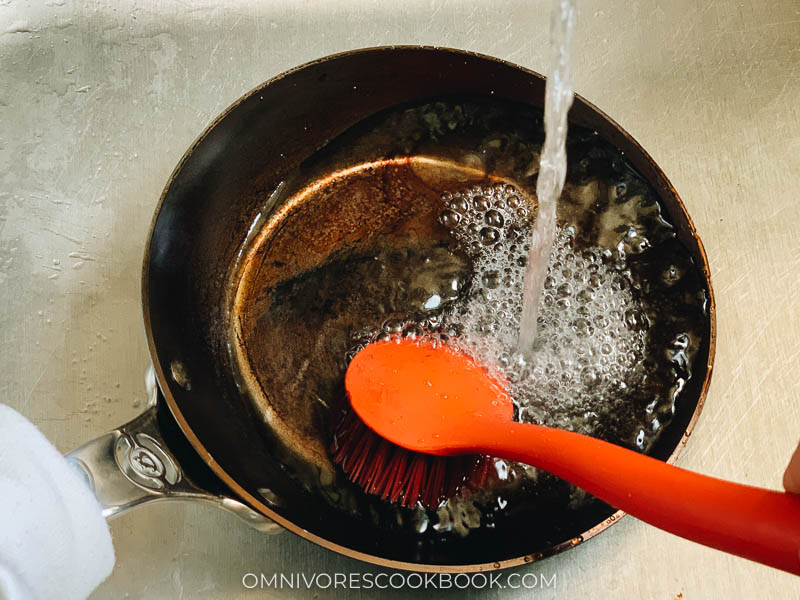
NOTES
The last step is very important if your pan is quite new. When your pan is well seasoned (anall-back patina has formed all over the interior), you don’t have to do the last step every time.

Things to avoid
- Do not use dish soap to wash your pan, since it will wash off the seasoning. However I do use some dish soap to wash the handle of the pan if it’s greasy. Just avoid getting the soap inside the pan.
- Do not soak your pan. It will cause it to rust.
- Never wash your pan in the dishwasher.
- Do not use steel wool to scrub the pan. It will scrub off the seasoning.
How to clean your pan if the food residue doesn’t come off
Sometimes you might have burned some food onto the pan and it won’t come off, no matter how hard you scrub it. Also, sometimes you might see uneven bumps caused by half-oxidized oil particles.
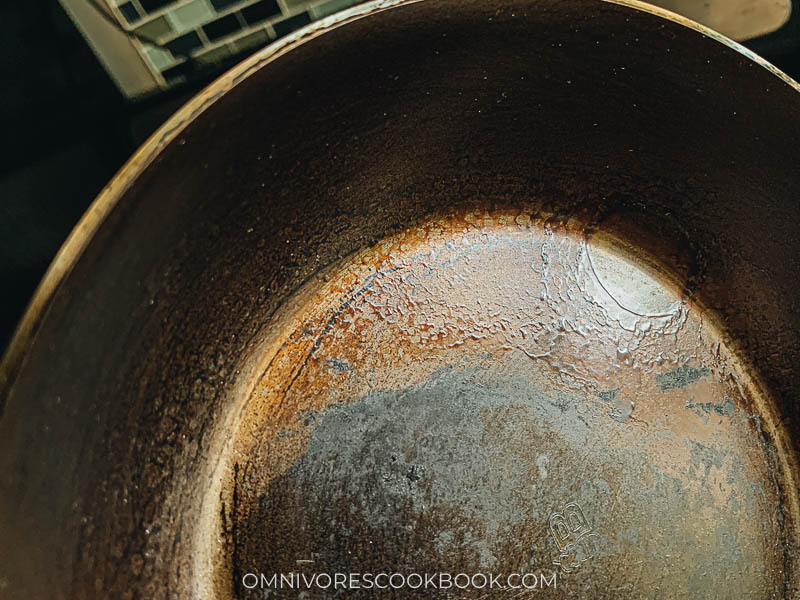
In this case, you should use this method to deep clean your pan:
- Spread a thin layer of salt onto the pan. Heat it over medium-high heat until hot.
- Scrub it with a few layers of paper towels (you can use a pair of tongs to grab the towels to prevent burning your hands) or a wooden spatula. The salt will help remove the food residue and the lingering particles from previous cooking.
- Once done, rinse the pan with hot water to clean off the salt. Dry the pan thoroughly with paper towels, heat it over the stove, and rub it with a thin layer of oil as instructed above.
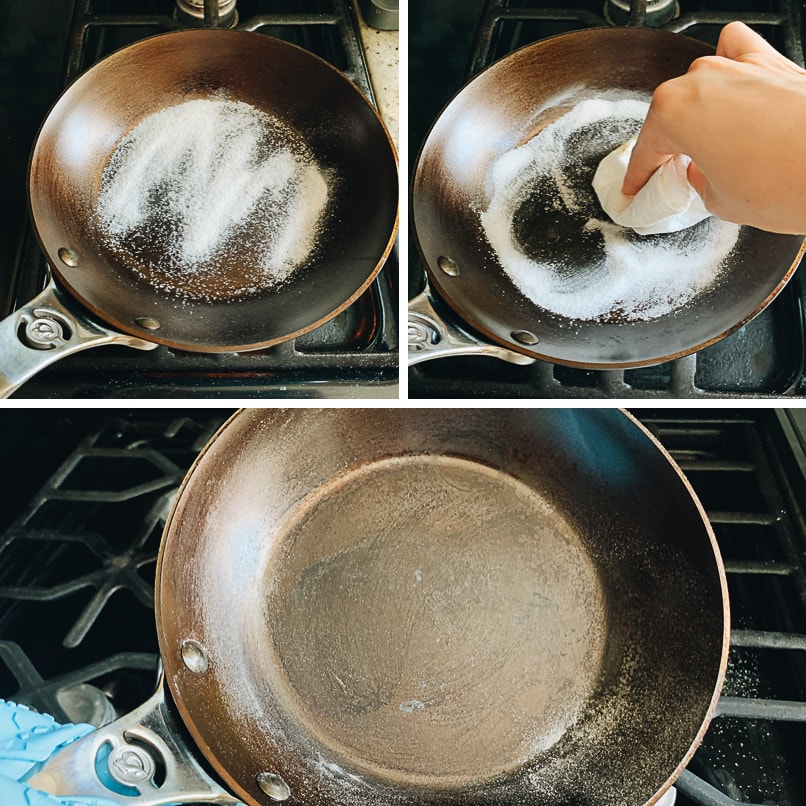
Best practices for cooking with a newly seasoned carbon steel pan
- Use your newly seasoned pan to cook vegetables, deep fry, or shallow fry food.
Your carbon steel pan will be quite nonstick after the patina has built up. But for a newly seasoned pan, your food might still stick. Here are some recipe ideas:
- Chinese Fried Pork Chops
- 4-Ingredient Baby Bok Choy Stir Fry
- You Tiao (Chinese Donuts)
- Salt and Pepper Shrimp
- Chinese 4-Ingredient Fried Cabbage
- Always use more oil when you’re cooking with a new pan. This will help the pan to build up a patina and become more nonstick in the future. And note, you will always end up using a bit more oil with a carbon steel pan, compared to a nonstick pan.
As soon as I seasoned my new pan, I cooked fried eggs using 2 teaspoons of oil. The eggs came off easily without sticking, but the oil was all gone, absorbed by the pan for further seasoning.
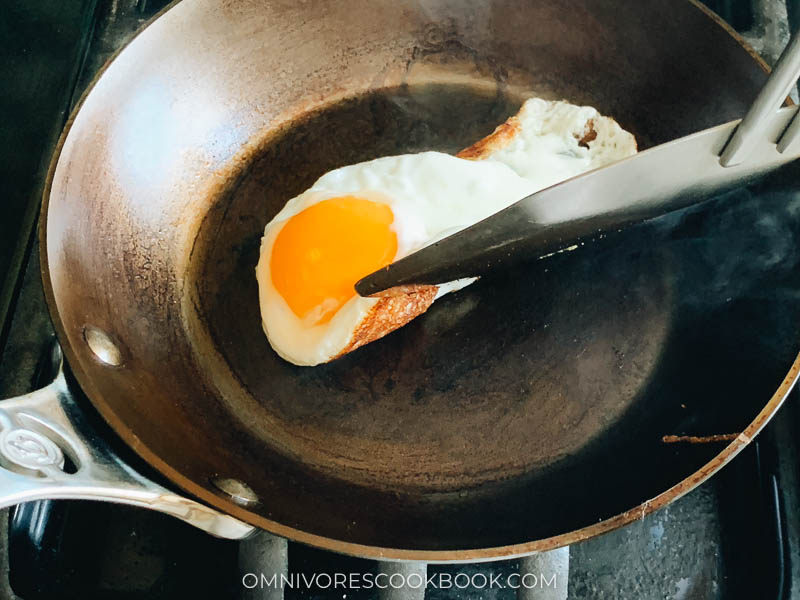
- Avoid cooking starchy food in it or use a bit more oil. If you cook stir fries that contain cornstarch (most recipes with protein contain it), you’ll need to use more oil to prevent sticking. Noodles and rice will be trickier and they tend to stick.
- Do not use the pan to cook any acidic food. Lemon juice, tomato sauce, vinegar, and anything that is slightly acidic will undo the seasoning. They will react with the coating and cause the seasoning to come off. And your food will end up tasting a bit metallic. On the other hand, once your pan is well seasoned (it has an even, black coating), you could get away with cooking acidic food if you don’t cook it for very long. For example, it’s possible to make General Tso’s Chicken in a well-seasoned 12” carbon steel fry pan even though the dish contains vinegar, because the sauce will only stay a few minutes in the pan. On the other hand, if you’re making a tomato-based stew, the longer cooking time will unseason the pan. I recommend you not do so, even with a well seasoned pan.
- Do not use the pan to braise or boil food. It’s common practice to braise and boil food in a wok in Chinese cooking. However, when you do so with a new carbon steel pan, the seasoning tends to come off due to the salt content in the liquid. But once your pan is well seasoned, it’s totally fine to braise and boil food in it.
Carbon steel pan cooking tips
- Heat up the pan until it just starts to smoke, and then add the oil. This will help prevent sticking when you cook meat or starchy food.
- More searing and less stirring. When you add the food, especially when it’s protein (meat, eggs, tofu etc.), it’s important to let the food sear in the oil without moving it around. Once the protein is cooked, it will release from the pan easily without sticking. Same idea with fried rice. When the rice crisps up, it will release from the pan with a single scrape of your spatula.
- Always use a bit more oil. It helps.
- If food starts to stick, deglaze the pan. Drizzle some Shaoxing wine or chicken stock, or a bit of water into a hot pan and scrape it with your spatula. The brown bits should come off easily and the liquid will evaporate. This step will make your food taste better too.
- If your pan has food stuck on it, scrub it to remove all residue if possible once you finish cooking (see the methods above). Sometimes, it doesn’t matter if there’s only a bit of residue, which will come off next time you cook with the pan. But food residue might build up and cause more sticking in the future if you do not clean the pan carefully.
It might sound like a lot of work to take care of a carbon steel pan. And yes, there’s a bit of a learning curve. But if you try it a few times, you will find that it is not that complicated and you’ll build up your routine easily. This means the pan will last a lifetime and it will always help you cook better food.
Did I forget anything or do you have more questions? Leave a comment below and I’ll try my best to answer.
Happy cooking!
More posts you might be interested in
- Why a Carbon Steel Pan is the Best for Stir Fry
- How to Season a Carbon Steel Pan
- Wok vs. Stir Fry Pan – Which is the Right Tool for You?
Want to learn more about Chinese Cooking? Sign up my newsletter to receive the 5-Day Chinese Cooking Crash Course and recipe update!













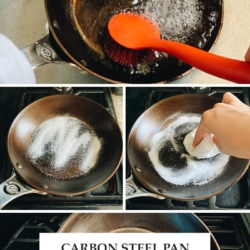
Any tips on how to revive a carbon steel pan? I have done all the bad things I didn’t know not to do — soaking, dish soap, etc. The pan is kind of rusty. How do I remove the rust and start over?
Completely strip the pan, and start fresh.
Barkeeper’s Friend is great for scrubbing rust off carbon steel pans.
I seasoned my new pan like you instructed and it seemed great. I cooked a chicken breast with some oil — the breast was seasoned with salt and pepper and New Mexico red chili powder. It cooked perfectly, and released fine, and when I turned it, I put the pan into the oven (at 350 degrees) for five more minutes. Seemed perfect. But the seasoning in the area where the chicken cooked was gone and I could see the metal. What did I do wrong? How should I proceed?
It’s quite common that some of the seasonings will come off when your pan is still pretty new. The salt and high heat will have that effect.
I would clean up the pan using runny water, wipe it dry, heat it on stove to let it dry completely, rub with a thin layer of oil and heat a bit more. Next time when you use it, add a bit more oil when cooking to let the pan absorb some to re-season. After repeating this process for a while, your pan will build up the patina and the seasoning will stay better.
Hello, I can’t find the storing part of article. I apologize if it’s in there. I have three carbon steel pans and I don’t want to leave them on the stove top as they take up to much space. Can I stack them in a cabinet? Do I need a paper towel or something between the layers? Thanks
It’s totally OK to stack them in a cabinet without placing any paddings in between. When you remove them from the cabinet to use them, try to lift the pan instead of dragging it against each other so it doesn’t scratch the seasoning (the pans themselves are durable and won’t be damaged).
I agree with most of what you say, but I would recommend adding that running a hot pan under water (even if it is hot) can warp the carbon steel. You have to find that sweet where the pan is still hot, but cool enough that metal won’t warp.
Hello! Great articles on Carbon Steel! I am converting to using both Carbon Steel and Cast Iron from now on. One quick question…for some reason I can’t find this answer online. When I post season (after cleaning and drying) I add a thin layer of oil but I feel like I’m over-cooking the oil. How long and how hot should you post season with a thin layer of oil after cleaning? get it smokey and then turn off the heat? or keep it going once it smokes? Thanks and one of the better articles on carbon steel!
Happy to hear you find this post helpful!
For post season, I wouldn’t heat the thin layer of oil for too long. If you see a bit smoke coming off, turn off the heat. If you keep going after it starts to smoke, essentially you’ll be seasoning the pan again (which is totally fine). But it’s not needed since the pan will be slowly building up the patina naturally when you cook with it again and again.
I’ve been looking at carbon steel and cast iron pans to be my first really good pan. But I’m a bit confused with the acidic foods.
Should it be a two pan set? one for proteins and veggies and another for sauces and acidic food?
If that’s the case, what should be the other pan?
Can you help me clarify this?
In general it’s not recommended to cook acidic food in carbon steel (and cast iron) pan because it will un-season the pan. That being said, once your pan is well seasoned, it’s totally OK to add a splash of vinegar or lemon juice here and there in a stir fry without too much issue.
However, if you’re talking about braising tomato sauce for a longer time, it’s the best to use a stainless steel pan or nonstick pan.
I do use two pan set at home due to the same reason.
Hi. Thank you for your great article on carbon steel pan. May i ask after cleaning the carbon steel pan, i have to give it a layer or oil coating for storing.
Do i have to give it a rinse with water and brush the pan, when i want to use it again ? I find it weird to cook with a layer or oil coating from the day before.
Can i wash with room temp water instead of warm/hot water ?
If you do not feel comfortable with the coated oil on the pan, I would brush the oil, then turn on the heat to heat up the pan. The oil will be absorbed when the pan is hot, and you can wipe off any excess oil if there’s any left. This is a better way to protect the pan (I sometimes only brush oil without the heating because it saves me some time).
If you have brushed the oil without heating, the next day you can rinse the pan before using. And as long as you use a generous amount of oil to coat the bottom of the pan during cooking, it will be OK.
And yes, you can wash the pan in room temp water.
This was the most helpful guide to using carbon steel that I have found. I also looked at your post about seasoning carbon steel pans. Thank you so much!!!! I was about to give up on my new carbon steel pan due to poor advice on how to season and use it but I’m actually cooking with it right now!!
So happy to hear that you find this guide useful! A carbon steel pan definitely needs a bit time to get used to, especially when it comes with controlling the heat. Please feel free to reach out anytime if you have questions and happy cooking 🙂